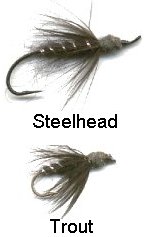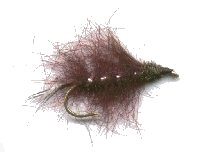
The Caverhill
Nymph & The Helen's Heller
The story
behind two of BC's best fly patterns
History
of the Caverhill Nymph
The following
history of the Caverhill Nymph is from Art Lingren's Fly
Patterns of British Columbia
During the
1960s and ‘70s Helen Peacock of Kamloops
worked as a professional fly tier; one of her creations was called the
Helen's Heller and the Caverhill Nymph owes its origins to Peacock's creation.
In a November 1994 letter about the Caverhill Nymph, Peter says that "this
fly was simply a case of lazy misidentification and sloppy fly tying ...
I thought that I had been tying a Helen's Heller; however those with greater
knowledge and understanding realized this error and had to call it something,
[and] they decided to give it my moniker."
A fly's reputation
is often bolstered when the fishing is slow and what few fish are caught
are consistently deceived by that pattern. During and October trip to
Dragon
Lake, this happened with the Caverhill Nymph and was recorded by Jim
Kilburn in March 1975 issue of Western Fish & Game. Skeptical about
veteran feather tossers' Jack Vincent and Bob Backus, advice that the
fish were targeting only the Caverhill, Kilburn stuck with his favoured
Anderson's Stone Nymph for most of that first fishless day and writes:
That
night, warmed by campfire and companionship, I calmed down somewhat.
I even listened more attentively, and I learned that the few trout that
had been taken had been victimized by a strange, black, seedy-looking
concoction called the Caverhill nymph....
At daybreak,
I was anchored on my favourite shoal, casting with the sink-tip. Early
morning came and went. So did 100 casts with a well-chewed Anderson
nymph...By late afternoon, I was still fishless. And frustrated...
When
I stopped at the Vincent-Backus camper, I was fishless, frigid, and
frustrated....There I learned that the majority of the trout hooked
that day had taken the Caverhill nymph...I....suggested that the cold
fishless specimen standing before them required....several Caverhill
nymphs...Being gentlemen, they took the bait on each cast....
On the
following five days, I was able to estabilsh that the trout did indeed
favor the Caverhill nymph. And, even though fishing was slow by standards
of previous years, I did manage to hook 16 trout to eight pounds-fishing
reasonably hard.
To top Kilburn's
trip, Joyce, Kilburn's wife, took a 9 ½-pounder on a Caverhill Nymph.
When I asked
Caverhill for a fish story, he referred me to Kilburn's story partially
detailed above and noted that the fly was featured in Alf Davy's book
The Gilly (1986). "However, the fly must be pretty widely used and appreciated
because I'm constantly questioned by new fly fishers that I meet about
the Caverhill Nymph," said peter.
Twenty years
has lapsed since Peter made that fly-tying faux pas, but the fly like
the ardent fly fisher and fisheries branch biologist, Caverhill, lives
on.
-from
Art Lingren's Fly
Patterns of British Columbia

 Caverhill
Nymph Fly Pattern Caverhill
Nymph Fly Pattern
Hook:
Number 6 to 10, Mustad 9671 or 9672
Body: Blue-black mohair
Rib: Flat or oval, silver tinsel
Collar: Blue-black hackle
Head: Peacock herl-coloured yarn or peacock herl
Originator: Peter Caverhill
Intended Use: Wet fly for rainbow
trout
Location: Dragon Lake
Over the
years the Caverhill Nymph has been a popular pattern with BC anglers,
as evidenced by the following E-Mail sent to Peter.
February
13, 1998
Hi...
Is this the Mr. Caverhill who developed the fly pattern bearing the
Caverhill name? Thanks for a wonderful fly...when if first appeared
in the issue of western fish and game back then, I immediatly sized
it up to a mustad 36890 #2, and proceeded to angle up lots and lots
of Bulkley River steelhead...I use the fly to this day, and it's as
good as ever. Again, thanks for a winner!!!
PS...in
the trout size, it works good, too...but you already knew that. Regards,
KD.


The Helen's
Heller
The following
history of the Helen's Heller was written by Williams Lake fly tier Paul
Carnes, president of the Cariboo Chilcotin Flyfishers.
The Helen's
Heller is a fly that I use all the time. I have used it throughout the
Cariboo-Chilcotin as searching pattern to find where the rainbows are.
I have caught rainbows, brookies, char and salmon with it and it has a
special place in my fly box as well as my heart.
When I first
came to Williams
Lake in 1972 I was not a fly fisherman. Through friends I picked up
the sport and the rapid loss of flies led me to flytying. I met Helen
Peacock, the originator of the Helen Heller, while searching for a flytying
class. Helen Peacock taught a evening course for Cariboo College but due
to the limited number who wanted the course that year, it was cancelled.
A group of us offered to pay her if she would teach us, which she agreed
to do at her home. Every Wednesday night we would gather around her kitchen
table, and she would pull out her suitcases of material and supplies and
teach us the basic techniques of flytying, usually three flies a night,
and how to fish them. We learned more on those nights than we would ever
have, if we were in a classroom.
The fly originated
when she was tying professionly for Butterfield's in Kamloops. One of
the principal ingredients is the use of seals fur, black and dark claret,
which you mix together. This translucent material is what gives the fly
movement and effectiveness. The rib can be silver or gold, the pheasant
wing can be eliminated, but the shape and feel is what the basic design
is all about. Helen Peacock said that it imitates a leech or dragonfly
nymph. Either trolling or casting it is an effective fly and because of
its historical roots in my flyfishing career it is special and one hell
of a fly to use.
Helen's
Heller Fly Pattern
Hook:
#8 or # 6 Mustad or Tiemco
 Tail:
6-8 fibres of Guinea Hen Tail:
6-8 fibres of Guinea Hen
Body: a mixture of black and dark Claret Seals fur
Ribbing: silver tinsel
Wing: pheasant tail
Collar: peacock herl
Originator: Helen Peacock
Intended Use: Wet fly for rainbow trout
Location: Kamloops area
After attaching
the tail and ribbing, form a dubbing loop. Place the seals fur in the
loop and twist to form a rope of fur dubbing. After the rib has been wound
up the body, tease the fibres out to give it a hairy appearance. The pheasant
tail wing is applied with one or two turns to hold in place. Pull the
fibres of the wing, so that you have only a short stubby wing. Apply the
herl with on or two turns and then finish off. -
Paul Carnes
Peter's
Arcticles...
|




 Caverhill
Nymph Fly Pattern
Caverhill
Nymph Fly Pattern Tail:
6-8 fibres of Guinea Hen
Tail:
6-8 fibres of Guinea Hen